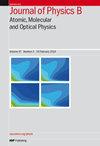双色慢速开启和快速关闭激光脉冲控制冷85Rb原子的光缔合
IF 1.5
4区 物理与天体物理
Q3 OPTICS
Journal of Physics B: Atomic, Molecular and Optical Physics
Pub Date : 2023-08-30
DOI:10.1088/1361-6455/acf53e
引用次数: 0
摘要
用量子波包方法研究了在100μK×kB双色激光脉冲作用下,85Rb原子从基态X1∑g+态到激发态A1∑g+和b3πu态的光缔合(PA)。两个失谐δ1和δ2在−1.0到1之间变化的脉冲。 cm−1。将具体情况δ1=-δ2推广到高斯脉冲场和慢通快关(STRT)场的δ1和δ2任意组合的条件。研究发现,在两个脉冲中引入失谐可以增强时间分布的不对称性,拓宽激光场的线宽。这两个因素可以进一步提高共振和非共振区域的PA概率。与高斯场相比,时间分布更加不对称、线宽更加加宽的STRT场可以显著提高PA概率,其中非共振跃迁主导了PA过程。可以预期,一旦两个失谐都是正的,这对相干控制来说是一个相对宽松的限制,那么在双色STRT场中可以获得相当大的PA概率。本文章由计算机程序翻译,如有差异,请以英文原文为准。
Steering photoassociation of cold 85Rb atoms by two-color slowly-turned-on and rapidly-turned-off laser pulses
Photoassociation (PA) of 85Rb atoms from the ground X1Σg+ state to the excited A1Σg+ and b3Πu states by two-color laser pulses at 100 μK×kB is investigated by using quantum wavepacket method. Two pulses with detunings δ 1 and δ 2 varying from −1.0 to 1. cm−1 are taken into account. The specific case δ1=−δ2 is generalized to the condition of arbitrary combination of δ 1 and δ 2 for both the Gaussian-pulse field and the slowly-turned-on and rapidly-turned-off (STRT) field. It is found that the introduce of the detunings in the two pluses can enhance the asymmetry of the time profile and broaden the linewidth of the laser field. The two factors can further enhance the PA probability for both resonant and nonresonant regions. Compared to the Gaussian field, the STRT field which is even more asymmetric in time profile and more broaden in linewidth can significantly enhance the PA probability, with the nonresonant transition dominating the PA process. It can be expected that once the two detunings are both positive, which is a relatively loose restriction for coherent control, a considerable PA probability can be obtained in a two-color STRT field.
求助全文
通过发布文献求助,成功后即可免费获取论文全文。
去求助
来源期刊
CiteScore
3.60
自引率
6.20%
发文量
182
审稿时长
2.8 months
期刊介绍:
Published twice-monthly (24 issues per year), Journal of Physics B: Atomic, Molecular and Optical Physics covers the study of atoms, ions, molecules and clusters, and their structure and interactions with particles, photons or fields. The journal also publishes articles dealing with those aspects of spectroscopy, quantum optics and non-linear optics, laser physics, astrophysics, plasma physics, chemical physics, optical cooling and trapping and other investigations where the objects of study are the elementary atomic, ionic or molecular properties of processes.

 求助内容:
求助内容: 应助结果提醒方式:
应助结果提醒方式:


